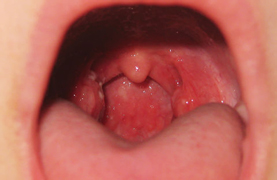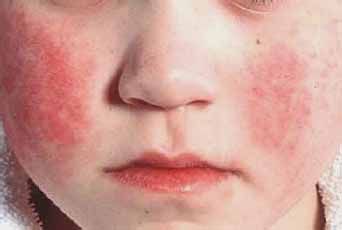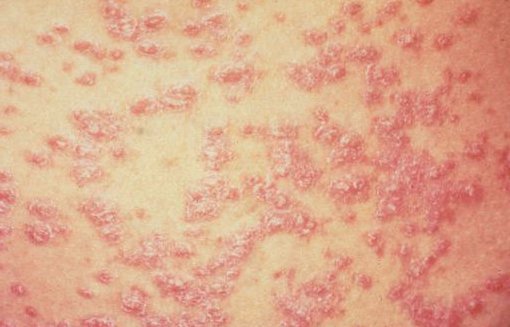Fecal streptococcus in the throat. What are the main symptoms of streptococcus in the throat?
Streptococcal throat infection is a group of diseases caused by such a pathogenic bacterium as hemolytic streptococcus. Streptococci in the throat are present in all healthy people, but under unfavorable circumstances, these bacteria can cause the development of an inflammatory reaction. Diseases of this group may differ from each other in a particular type of localization and may have different symptoms.
What is Streptococcus
Streptococcus is a Gram-positive spherical bacterium from the lactobacillus family. Often it coexists with such a bacterium as Staphylococcus aureus. Streptococci in the throat are classified into 3 types:
- alpha hemolytic streptococcus;
- gamma streptococcus (non-hemolytic);
- beta hemolytic streptococcus (groups A through U).
Alpha-hemolytic streptococcus is differently called greening streptococcus due to its ability to dye the blood environment green (the bacterium produces partial hemolysis of red blood cells). Alpha and gamma streptococci are the least harmful to humans, and all the major diseases of the throat are usually caused by beta-hemolytic streptococcus group B and group A. Beta-hemolytic streptococcus causes complete hemolysis of red blood cells.
Bacteria in most cases cause streptococcal tonsillitis (sore throat) and pharyngitis, or tonsillofaringit. Less frequently, the child and adults have symptoms of streptococcal laryngitis. Get familiar with the symptoms and treatment of laryngitis in a child
Causes of Streptococcal Infection
The most common pathogen of infection is Streptococcus pyogenes, which causes streptococcal sore throats, pharyngitis. In children, the main cause of the development of the disease is the primary infection with the infection or a strong weakening of the immunity against the background of acute respiratory viral infection, as a result of which the bacteria on the pharyngeal mucosa begin to increase the number of their colonies.
In adults, the cause of the activation of the infection can be bad habits, especially smoking, as a result of which the mucous membrane is damaged and becomes more susceptible to the disease. Increase the likelihood of strep throat:
- heartburn - ingestion of gastric juice in the esophagus and pharynx;
- immunodeficiency states;
- long-term use of glucocorticosteroids, chemotherapy.
It's hard to get rid of streptococcal infection, which the man contracted in the hospital. Often in medical institutions, patients have bacteria that have already developed significant resistance to antibiotics, so treatment will be much more difficult.
Hemolytic streptococcus group B - a component of the genital organs of women, which can increase the number during pregnancy. Therefore, bacteria can appear in a newborn baby immediately after birth, as the infection was received by it in childbirth. Prolonged delivery, premature rupture of membranes and some other factors increase the likelihood of infection. In the presence of streptococcal infection in the mother in half of the cases, it is transmitted to the baby.
In a child, infection may occur in more late terms when in contact with mucous membranes of family members, others who are asymptomatic carriers or ill. More often infect premature babies who have violated the mechanisms of obtaining antibodies from the mother. Children can become infected with streptococci at any age through droplets when sneezing, coughing, especially often with prolonged contact with the patient, in a hot, dusty room. Infection can occur through household items, toys, which regularly happens in children's groups.

Symptoms and types of pathology
The incubation period for bacteria is 1-4 days. The clinical picture of the disease often varies depending on the age of the person. In children, the development of the disease is rapid: after a slight indisposition and chills, the appearance of pronounced symptoms. The child has early age (usually after 6 months, when the mother’s antibodies cease to circulate in the blood) such symptoms can occur:
- moodiness, irritability, crying;
- refusal to eat, to suck the breast;
- fever;
- discharge from the nose of a yellow, green color;
- nausea, vomiting.
An older child can already try to find out what symptoms and sensations bother him. Children become lethargic, sleep more, they lose their appetite, their lymph nodes in the neck grow. Complaints kids impose on sore throat, scratchy, dry, podkashlivanie, headache. Body temperature in streptococcal infections in the throat is usually high: in children 3-10 years old, it can reach 39-40 degrees.
When viewed from the throat can be noted redness of the tonsils, the appearance of abscesses or purulent plaque. With the development of purulent processes, the patient’s well-being may deteriorate sharply, the symptoms of general intoxication increase. With streptococcal pharyngitis, the patient has a dry cough, which later becomes wet and, if left untreated, quickly turns into tracheitis. If in children the pathology is supplemented with a rash on the body, this means the development of scarlet fever.
In adults, primary streptococcal tonsillitis can also be difficult and include all the above symptoms. Aggravation chronic tonsillitisusually flows less pronounced. The main complaints of the patients are weakness, nausea, low-grade fever, sore throat on both sides or on the one hand, swelling of the throat and face, loss of appetite, and increased lymph nodes.
In addition to diseases of the throat, streptococcal infection in parallel can also cause other organ damage. Often pharyngitis, sore throat, laryngitis is accompanied by otitis, sinusitis, adenoiditis, rhinitis, bronchitis. But, usually, these diseases become a complication of tonsillitis, which often occurs with inadequate therapy.
Possible complications of infection
Complicated course with streptococcal pharyngitis is less common than with tonsillitis, but it can still occur in people with weakened immunity. Early complications appearing on day 4-7 from the onset of streptococcal infection are:
- otitis
- sinusitis (usually sinusitis);
- paratonsillar, retropharyngeal abscess;
- lymphadenitis;
- bronchitis or pneumonia.
Of the late complications (2-4 weeks after the imaginary recovery), which are associated with the lack of treatment with antibiotics or with non-compliance with a course of therapy, there are:
- endocarditis, myocarditis;
- glomerulonephritis;
- acute rheumatism;
- meningitis;
- osteomyelitis.
If a child develops streptococcal bronchopneumonia, the foci of inflammation grow, merge with each other. This disease can spill over into pleurisy, empyema, severe necrotic lung diseases. In premature babies, this condition often causes death. The most severe complication Streptococcal infection that Staphylococcus aureus can supplement - its generalization with the development of sepsis.
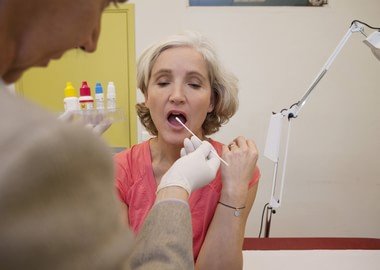
Treatment for strep throat
The duration of antibiotic therapy is 7-10 days. With severe course the disease is recommended administration of drugs in the form of intramuscular injections. The most common treatment for streptococcal tonsillopharyngitis is treatment with antibiotics from the penicillin group (based on benzylpenicillin, phenoxymethylpenicillin, ampicillin in combination with gentamicin). In chronic streptococcal tonsillitis, the patient is treated with protected penicillins (Flemoklav, Amoksiklav, Panklav).
If you are allergic to penicillins, streptococcal infection in the throat will help antibacterial drugs from the group of cephalosporins (Cefalexin, Supraks, Cefazolin) or macrolides (Erythromycin, Azithromycin). If scarlet fever is detected, it is recommended to take macrolides as first-line drugs for the mild form of the disease, cephalosporins for severe and moderate severity. The course of treatment for scarlet fever - 14 days. If the infection turns into complicated forms with systemic consequences, or has a tendency to generalization, aminoglycoside antibiotics are added to the course of therapy.
If your child has a sore throat as a result of the infection, you should consult a doctor and drink antibiotics during the entire course of treatment .. Treatment of pharyngitis with antibiotics also contributes to a speedy recovery.
Treatment must be complemented by symptomatic therapy:
- antipyretic drugs;
- taking a large amount of fluid;
- gargle;
- washing tonsils;
- sucking throat lozenges or pharyngeal irrigation with sprays; Read how to use drugs to irrigate the throat.
- sleep in the throat of antiseptics, including Streptocide;
- antibacterial drugs and antiseptics for irrigation of the nose;
- vasoconstrictor agents.
Usually, if all the measures of therapy prescribed by a doctor are observed, by the 5th day there is cleansing of the tonsils from the pus, cessation of cough and sore throat. But at the end of treatment before the course is completed, the relapse of the disease will be felt very soon, and the resistance of streptococci to antibiotics may become much higher.
Folk treatment of infection
Streptococcus can be treated in the throat by supplementing effective therapy. folk remedies. They have a symptomatic effect, contributing to the rapid reduction of the severity of the clinical picture, as well as reduce inflammation, increase immunity and wash out the infection:
- Brew in a glass of water a spoonful of wild rose berries and raspberry leaves, slightly mashed cranberries, leave for an hour, drink a warm drink. Repeat twice a day.
- Brew a spoonful of willow bark and turn in 300 ml of water, insist 2 hours. Apply to gargle. Learn how to gargle for pharyngitis
- Take a piece of propolis, chew it in your mouth for 5 minutes, repeat 3 times a day.
- Make a beet pulp, pour boiling water 1: 1. Leave for 6 hours under a tight lid. Add a spoonful of apple cider vinegar to the tool, strain, gargle every hour.

What not to do during illness
In order for the treatment of the disease in adults and the child to be successful, and the complications did not arise, it is necessary to observe some restrictions during the period of the disease. So you can not:
- ignore prophylactic antibiotics after close contact with infected streptococci, if a person has diabetes, immunodeficiency states, he is over 65 years old;
- don't care about thorough hygiene oral cavity and the whole body;
- supercool, drink cold drinks, eat cold foods;
- to carry the disease "on their feet";
- try to cure only folk remedies without antibiotics;
- keep smoking;
- eat annoying food, solid foods;
- drink little liquid;
- warm the throat with compresses, mustard plasters; Be sure to read how to put a mustard plaster on the throat
- to visit a bath, sauna;
- delay with the treatment to the doctor, including with repeated, if after 2 days of therapy there was no improvement.
Vaccine against streptococcal infection
Currently, immunization methods against streptococci are not developed. According to the researchers, the introduction of the vaccine could provoke severe immune reactions. Thus, after vaccination in children and adults, especially with a weakened body, complications can occur - kidney, heart, rheumatism.
For the prevention of the disease, it is better to observe the hygiene of the body and the home, to harden, play sports, eat fully, stop smoking, and not contact with infected streptococcal infection.
And in conclusion, we invite you to watch Dr. Komarovsky’s transfer of Streptococcus. Everyone has heard about diseases such as sore throat and scarlet fever, but few know that these diseases are associated with one microbe called streptococcus. Opera singer Vladimir Grishko came to see Dr. Komarovsky to find out what are the ways of infection with streptococcus, how dangerous this microbe is, how to treat it, and how long the patient is contagious.
Streptococcus in the throat can cause the spread of serious infectious diseases that can be cured by a certain group of medicines. The disease can be fully confirmed only in the case of studying a pharyngeal smear in a specialized laboratory. Self-diagnosis is not recommended.
They are mainly gram-positive bacteria, and some of them are conditionally pathogenic microorganisms. This happens because in a person’s blood during laboratory research streptococci are always found.
It is almost impossible to warn yourself against bacteria, they accompany people throughout their lives from the very moment of birth.
A person gets sick if his immunity has drastically decreased, the body frostbite has occurred, or if a new strain of microorganism has entered the bloodstream.
Streptococcus
Streptococcus in a throat swab in an adult can reveal the following types of microorganisms:
- Greening, or alpha-hemolytic, which partially destroy the red blood cells. They owe their name to the “greening” of the blood component.
- Pyogenic or beta-hemolytic, which most often cause a person to become infected with pneumonia, angina and other respiratory diseases.
- Non-hemolytic or gamma hemolytic, which cause most infectious diseases in humans.
Streptococcus in the throat in adults may not be dangerous, because there is a permissible concentration of bacteria that does not affect the livelihoods of people.
The disease only worsens if certain stimuli appear.
Bacteria in the throat
Increasing the concentration of pathogenic bacteria in the blood provokes infectious diseases that can occur in both mild and severe form. Severe form appears predominantly in the event that if the patient has weakened immunity. In addition, due to the lack of appropriate treatment of the disease cause serious complications.
It is dangerous that bacteria can be resistant to many drugs, including antibiotics. The most common diseases caused by bacteria include pharyngitis and tonsillitis.
Pharyngitis
Pharyngitis can occur in mild and severe form. Streptococcus in the throat in an adult with any form of the disease is increased, the rate rises to 10 in 6 degrees CFU / ml. The disease manifests itself quickly, even suddenly. In a patient, the mucous membranes of the throat become bright red in color and are covered with a grayish bloom.
As a rule, this disease causes group A streptococcus, which is sensitive to the antibiotic bacitracin.
Tonsillitis
Tonsillitis - throat diseasewhich is characterized by severe pain when swallowing food and water consumption. Note the acute and chronic form of the disease. The acute form manifests rapidly, the patient is diagnosed with bright symptoms. In most cases, the doctor can conditionally confirm the presence of the disease even by visual inspection.
In humans, the pharynx becomes red; inflammatory process on the mucous membranes of the larynx and grayish plaque. Below, as a visual example, presented a photo of streptococcus in the throat, which caused tonsillitis and inflammation of the tonsils.
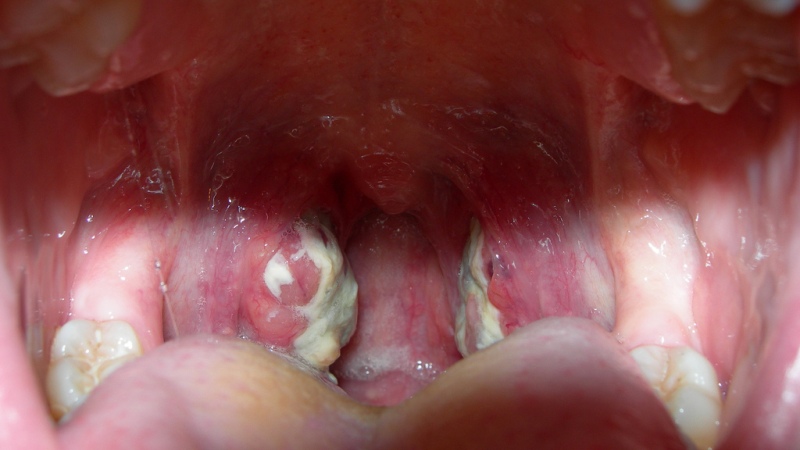
Tonsillitis - a disease caused by streptococci
Sometimes a patient is given a blood test.in which, in case of infection, an increased content of pathogenic bacteria will be revealed. Tonsillitis is considered one of the most common diseases in adults.
Many streptococcal infectious diseases are cured by early stage manifestations and disappear also suddenly. However, in the case of the course of the disease in severe form, serious consequences can be caused, in the form of a disruption of the natural work of the cardiovascular system, the development of rheumatism, sinusitis and other ailments.
With serious pathologies, streptococcus can be found in the throat 10 to 10 degrees.
Severe form appears predominantly if the patient has a severely low immunity.
The consequences are diagnosed most often in older adults, since the organisms in this population group are weak and susceptible to the spread of infection.
Causes of Strep Throat
Bacteria are in a certain amount in the body of every person on earth. While indicators of the content of streptococci are normal, should not worry. But with reduced immunity, the number of microorganisms in the throat can increase for a variety of reasons. The most key of them include the following:

- The use of unwashed vegetables and fruits often causes the spread of infection in the body. Often a person does not even suspect that he is doing something wrong. Many people simply rinse vegetables under water and find that they are already usable. This is not entirely true; it is better to put the products in a container with previously collected water and wipe them thoroughly.
- Pet game It may even be dangerous for a person with low immunity. Pets can be carriers of a large number of infections. A new strain of the streptococcus virus can be introduced into the human body from the fur or animal saliva.
- Pathogenic streptococcus you can get infected by other people. Bacteria are on personal belongings and ware infected. Often a dangerous microorganism penetrates the body of a healthy person when kissing an infected person.
The presence of the disease in humans can be accurately confirmed only by studying the biological material in the laboratory. The rate of streptococci in the pharyngeal smear depends on the individual characteristics of each person.
In some cases, a slight increase in performance is not a reason to start therapy.
Laboratory diagnosis of bacteria
Laboratory diagnosis of streptococci in the throat is made in the laboratory, experts are examining a patient's throat swab. Test results can only be ready after 4-5 days.
The purpose of the research is as follows:
- it is necessary to identify the strain of bacteria and the causes of their spread;
- confirm streptococcal infection and eliminate other bacteria;
- analyze the characteristics of microorganisms, and determine which group is sensitive.
Throat swabs are collected exclusively. sterile devices from the pharyngeal walls. Those particles of mucus that remain after collecting the analysis on the device are transferred to nutrient media.
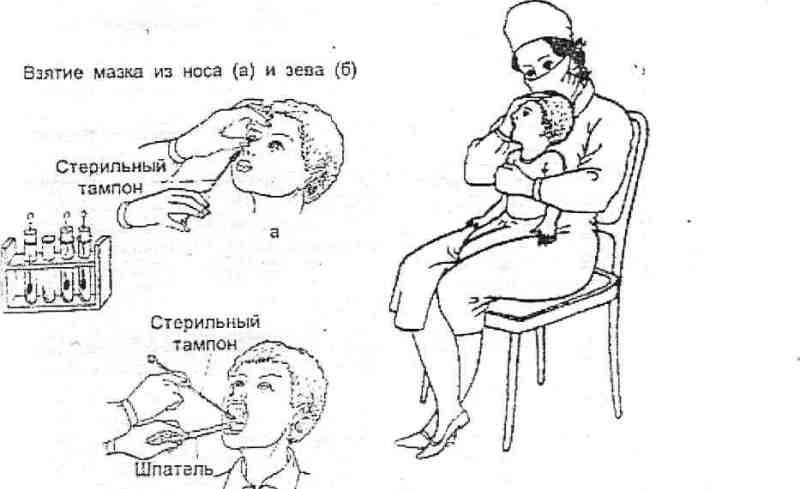
Taking a swab from the nose and throat
On the first day of laboratory research The biological material from the pharynx is spread on a cup with a favorable environment for the growth of bacteria, and is also placed in a test tube, into which glucose and other chemical compounds are poured in advance. The test tube is placed in a device called a thermostat, where a constant temperature of 37 degrees is maintained.
On the second day experts take test tubes in order to analyze the conversion of bacteria into colonies. On the dense surface of the nutrient medium, they resemble grayish ovals. Colonization of streptococci in a liquid medium is determined by formations in the form of crumbs on the bottom and on the walls of the tube. All colonies are stained with a special solution and examined with a microscope.
If streptococci were found in the colonies, they are sifted and put in broth with blood. This is a pure culture, and then the properties of the virus strain are identified.
On the third day using a special solution is determined by the type of bacteria. The agglutination reaction on the glass is also taken into account.
In order to determine whether a study is conducted on the sensitivity to antibiotics. This is done as follows: a suspension is applied to the Petri dish, which contains streptococcus. In the same capacity and placed the disks that are pre-soaked with antibiotics.
The reaction does not occur immediately, you must wait 10-12 hours. Antibiotics, around which was recorded the largest rate of suppression of bacterial growth, are the most effective.

To prevent pathology, it is enough to monitor the state of the immune system and follow the rules of personal hygiene.
The rate of streptococci in the pharynx can only be determined conditionally, since much depends on the individual characteristics of each person.
The spread of infection depends on the state of the human immune system.
The conditional rate is 10 to 4 and 10 to 5 degrees, respectively. The rate is conditional, as there were higher rates of streptococci in the smear, but the infection did not spread. However, if the biological material is taken to confirm the presence of bacteria in the throat, then the rate of streptococcus in a throat smear is calculated according to conventional indicators.
Bacteria surround people everywhere and it is virtually impossible to protect oneself from them. However, one can exclude oneself from the risk zone of infection with pathogenic streptococci. To do this, just follow the state of the immune system and follow the basic rules of personal hygiene.
In contact with
Mechanisms of development of streptococcal infections. Streptococcal Angina. Erysipelas Streptococcal pneumonia. Copyright treatment of streptococcal infections
Used in our center Chronic Infections Treatment Program give a chance:This is achieved through the use of:
- in a short time to suppress the activity of the infectious process
- reduce doses of anti-infective drugs and reduce the toxic effect of these drugs on the patient's body
- effectively restore the body's immune defenses
- prevent infection recurrence
- technology Autoplasma cryomodification capable of removing toxic metabolites of microorganisms from the body, inflammatory mediators, circulating immune complexes
- methods Extracorporeal antibiotic therapy providing delivery of anti-infective drugs directly to the site of infection
- technology Extracorporeal Immunopharmacotherapy working with cells of the immune system and allowing effectively and for a long time to increase anti-infective immunity
Streptococcus
Many streptococci are part of the normal microflora of the respiratory, urinary, genital and gastrointestinal tracts, but some types of streptococcus are important as pathogens of human streptococcal infections. Streptococcus group A (Streptococcus pyogenes) cause sore throat - one of the most common infections among school-age children, as well as well-known post-infectious diseases - rheumatism and acute glomerulonephritis. Streptococcus group B (Streptococcus agalactiae) are the main causative agents of such infections as sepsis and meningitis in newborns, postpartum sepsis and endometritis.
Enterococci occupy an important place among the causative agents of urinary tract infections, abscesses of the abdominal cavity, infectious endocarditis. Green streptococci are the main causative agents of infective endocarditis.
Streptococci are round or oval gram-positive bacteria that form characteristic chains on liquid media. Most types of streptococci that are pathogenic to humans are facultative anaerobes, but there are obligate ones among them. For the cultivation of streptococci need selective medium.
Classification of Streptococcus
There is no uniform classification of streptococci. Doctors and clinical microbiologists use two classifications of streptococci - by type of hemolysis and by serological properties (Lansfield classification), as well as by common names along with the Latin generic and species.
At the base lansfield classification there are differences in the structure of the polysaccharide antigens of the cell wall, the serogroup of streptococci are indicated in it by capital Latin letters. Colonies of many streptococci pathogenic to humans on blood agar are surrounded by a zone of complete hemolysis (the so-called β – hemolysis). Such streptococci are called β – hemolytic. Almost all streptococci of groups A, B, C and G are β – hemolytic. Around the α– colonies hemolytic streptococci a zone of partial hemolysis is formed, often colored in a greenish color. α – hemolytic streptococci are distinguished by their biochemical properties. Streptococcus pneumoniae (pneumococcus), one of the most frequent causative agents of pneumonia, meningitis and a number of other infections, and green streptococci belong to them. Green streptococci are part of the microflora of the oral cavity and cause subacute infective endocarditis in humans. Streptococci that do not produce hemolysis on blood agar are called γ – hemolytic. The main streptococci pathogenic for humans are listed in Table. one.
Enterococci, previously attributed to group D streptococci, are distinguished into a special genus based on DNA structure. Their names are changed accordingly. So, Streptococcus faecalis is now called Enterococcus faecalis, Streptococcus faecium - Enterococcus faecium.
Table 1. Pathogenic streptococci
| Lansfield Groups | Representative Representatives | Type of hemolysis | Typical nosological forms |
| A | Streptococcus pyogenes | β | Angina, impetigo, erysipelas, scarlet fever |
| B | Streptococcus agalactiae | β | Sepsis and meningitis in newborns, postpartum sepsis, urinary tract infections, diabetic foot, Infective endocarditis |
| C | Streptococcus equi | β | |
| D | Enterococci: Enterococcus faecalis, Streptococcus: Streptococcus bovis | γ | Urinary tract infections, wound infections, Infective endocarditis |
| γ | Infective endocarditis | ||
| G | Streptococcus canis | β | Erysipelas, Infective Endocarditis |
| Non-grouped | Green streptococci: Streptococcus mutans, Streptococcus sanguis | α | Infective endocarditis, periodontitis, brain abscess |
| Streptococcus intermedius complex: Streptococcus intermedius | β, α | Brain abscess, abdominal abscesses | |
| Peptostreptokokki: Peptostreptococcus magnus | γ | Sinusitis, pneumonia, empyema, brain abscess, liver abscess |
Streptococcus group A
This group of streptococci includes only one species - Streptococcus pyogenes. As the name implies bacteria, this group of streptococci causes purulent infections. In addition, Streptococcus pyogenes is the only culprit in post-infectious diseases - rheumatism and acute glomerulonephritis.
Pathogenesis of infections caused by group A streptococci
The surface structures of group A streptococci and the exotoxins and enzymes produced by these streptococci play an important role both in the pathogenesis of streptococcal infection and in the development of the immune response of the microorganism. The cell wall of streptococci of this group contains a group of polysaccharide antigen A, extracted with acids. The reaction of such extracts with group-specific antibodies is used to judge whether the isolated strains belong to the species Streptococcus pyogenes. The main surface antigen of group A streptococcus is protein M. Protein M molecules are strengthened in the cell wall of streptococcus and form filamentous outgrowths on it. More than 80 variants of this protein are known, each of which is peculiar to a specific serotype of streptococci, that is, serves as a type-specific antigen. The variants differ from each other by the sequence of amino acids in the distal (N-terminal) part of the molecule; the proximal part of the molecule is little affected by changes. Protein M provides group A Streptococcus resistance to phagocytosis in human blood. Obviously, it binds fibrinogen, thereby preventing the activation of complement and opsonization by fragments of complement streptococci. Antibodies to protein M eliminate the resistance of group A streptococci to phagocytosis. After streptococcal infection, type-specific immunity is produced; it only protects a person from Streptococcus pyogenes strains of the same streptococcal serotype to which the pathogen of the infection it suffered belonged. Streptococci of group A have a different thickness polysaccharide capsule consisting of hyaluronic acid. Strains of streptococci with a well-defined capsule form mucous colonies. The capsule also plays an important role in protecting group A streptococci from being captured and destroyed by phagocytes. Unlike protein M, it has weak immunogenic properties, apparently due to the structural similarity of the hyaluronic acids of bacteria and mammals. Antibodies to it do not play a significant role in immunity.
Exotoxins and enzymes produced by group A streptococci have local and systemic toxic effects and contribute to the spread of infection in the body. Exotoxins and enzymes produced by group A streptococci include streptolysins S and O, which damage cell membranes and cause hemolysis, streptokinase, deoxyribonucleases, proteases and erythrogenic toxin types A, B and C (also known as pyrogenic exotoxin). The action of the erythrogenic toxin Streptococcus is caused by a rash in scarlet fever. Recently, toxin-producing strains of Streptococcus pyogenes have been found to cause particularly serious infections, including necrotic fasciitis and streptococcal toxic shock. Many of the exotoxins and streptococcal enzymes produce antibodies; their presence indicates a recent streptococcal infection. The determination of the titer of these antibodies is used in cases of suspected rheumatism and acute glomerulonephritis.
Streptococcal Angina
Strep throat occurs at any age, but is most common among children, where streptococcal angina accounts for 20–40% of all angina. In children younger than 3 years old, sore throat is rare, and streptococcal infection is accompanied by fever, malaise, and enlarged lymph nodes without damage to the tonsils. The source of infection is the patient or carrier; infection usually occurs through airborne droplets. There are other ways of transmitting streptococci, for example, alimentary (described outbreaks).
The incubation period of streptococcal sore throat is 1-4 days. The clinical picture of streptococcal angina includes sore throat, fever, chills, malaise, and sometimes abdominal pain and vomiting, especially in children. Symptoms of streptococcal angina are quite diverse: from discomfort in the throat and subfebrile temperature to high fever and severe pain in the throat with severe hyperemia and edema of the mucous membranes, and purulent raids on back wall pharynx and tonsils. Cervical lymph nodes are usually enlarged and painful.
The differential diagnosis should include angina and pharyngitis of a different etiology, both bacterial and viral. In particular, attacks on the tonsils often occur with adenovirus infection and infectious mononucleosis. Similar changes in the throat gives diphtheria. Angina, often in combination with a scarlet-like rash, is caused by Arcanobacterium haemolyticum (the outdated name is Corynebacterium haemolyticum). For pharyngitis caused by Coxsackie and influenza viruses, mycoplasmas and gonococci, as well as during the acute febrile phase of HIV – infection, purulent raids on tonsils usually do not occur. Since the clinical picture of streptococcal sore throat is diverse and has no peculiarities peculiar only to it, it is impossible to make a diagnosis according to one clinical data.
The most sensitive and specific method for the diagnosis of streptococcal tonsillitis, which makes it possible to make a definitive diagnosis, is sowing a smear from the pharynx. Smear taken with a sterile swab, with some pressure, holding the arms of both palatine tonsils. A useful addition to the smear culture is the rapid tests for streptococcal antigens. For this purpose, two types of diagnostic kits based on latex agglutination and ELISA are sold. The specificity of rapid diagnosis exceeds 95%, which, with a positive result, allows you to confirm the diagnosis without seeding. However, the sensitivity of rapid diagnosis is low (from 55 to 90%), therefore, with a negative result, it is possible to confirm or reject the diagnosis of streptococcal tonsillitis only with the help of seeding.
Uncomplicated streptococcal tonsillitis lasts 3-5 days. Treatment does not significantly affect the duration of streptococcal angina. The main goal of treatment is to prevent purulent complications and rheumatism. For the latter, it is necessary to eradicate streptococci from the mucous membrane of the pharynx, for which benzathine benzylpenicillin is injected intramuscularly once or phenotymethylpenicillin is taken orally for 10 days. If you are allergic to penicillins, they are replaced with erythromycin. With frequent streptococcal infections in this patient or his family members, as well as at high risk of rheumatism (for example, cases of rheumatism have recently become more frequent) after treatment, it is advisable to repeat seeding of the throat swab after treatment.
Due to the widespread use of antibiotics, purulent complications of streptococcal tonsillitis are now rare. These complications develop as a result of the direct spread of infection from the pharyngeal mucosa to the deeper tissues of either hematogenous or lymphogenous dissemination. Cervical lymphadenitis, peritonsillary and pharyngeal abscesses, sinusitis, otitis media, meningitis, sepsis, infective endocarditis and pneumonia. Peritonsillar abscess should be suspected in case of unusually severe condition of the patient, prolonged course of angina, complaints of sore throat in combination with high fever and intoxication.
Streptococcus carrier
During mass examinations (crops of swabs from the pharynx), up to 20% of group A streptococcus carriers are found among some population groups. Regarding whether carriers of streptococci should be treated, including whether to continue treatment in the case of carriage after angina, there are no official recommendations. It is generally recognized that it is not necessary to treat a carrier of streptococci, which has already received a ten-day course of phenoxymethylpenicillin, if it does not have a recurrence of angina. Studies show that with streptococcus carriage the risk of rheumatism and transmission of the pathogen to healthy individuals is significantly lower than with angina, so attempts to actively eradicate the carriage of streptococci are in most cases not justified. However, sometimes carriers of streptococci become causes of outbreaks of streptococcal infection (caused by nutritional infection or hospital - in maternity hospitals). Therefore, carriers of streptococci, which can spread the infection in the performance of their professional duties, must be treated. The carriage of group A streptococci in the nasopharynx, on the skin, in the vagina and in the rectum is described. For streptococcal carriage in the nasopharynx, rifampicin with phenoxymethylpenicillin is prescribed; during carriage in the rectum, vancomycin is added to them. The experience of using any antibiotic regimen to eradicate carriage is small.
Scarlet fever
The clinical picture of scarlet fever usually consists of a sore throat (less often a different streptococcal infection) and a characteristic rash. The rash is caused by one of three types of erythrogenic toxin - A, B or C, produced by streptococci. Previously, it was believed that scarlet fever occurs when people with toxin-neutralizing antibodies are infected with toxigenic strains of Streptococcus pyogenes. Susceptibility to scarlet fever was assessed using the Dick reaction: intradermal administration of erythrogenic toxin in susceptible individuals causes redness at the injection site; in the presence of toxin neutralizing antibodies, redness does not occur. Subsequently, it was shown that a scarlet rash may be due to an allergic reaction, which suggests a previous sensitization with an erythrogenic toxin. For unclear reasons, the incidence of scarlet fever has decreased in recent years, although toxigenic strains of Streptococcus pyogenes are still widespread among the population.
Scarlet fever is characterized by the same complaints as sore throat. The rash usually appears on days 1-2–2 of the disease on the upper half of the body and then spreads to the extremities. Soles and palms remain free from rashes. The rash is punctate, consists of tiny papules, so the skin feels like sandpaper to the touch. In addition, pallor of the nasolabial triangle, strawberry tongue (coated tongue with prominent red nipples, later on the tongue coming off the tongue), a bright rash in the skin folds in the form of lines - symptom Pastia. After 6–9 days, the rash is resolved, and a little later, peeling of the palms and feet occurs. The differential diagnosis should include other diseases that are accompanied by fever and rash: measles, viral infections, Kawasaki disease, toxic shock, allergic reactions (in particular, drug rash).
Infections of the skin and soft tissue caused by streptococci
Group A Streptococci (and sometimes other types of Streptococcus) cause a variety of infections of the skin, subcutaneous tissue, muscles, and fascias. The classification of these infections is based on the type of affected tissue and is very conditional in nature, since in practice their cross forms are often found. Knowledge of the classification and familiarity with the classic forms of these infections helps to assess the depth of tissue damage, predict the course and outcome of the disease, predict the need for surgery and intensive care.
Impetigo
Impetigo is a superficial skin infection that is caused by Streptococcus pyogenes, and sometimes other types of Streptococcus or Staphylococcus aureus. Impetigo mainly affects young children. It is more common in the warmer months and more common in tropical and subtropical climates. Impetigo children living in unsanitary conditions are particularly susceptible. In prospective studies it was established that the disease is preceded by seeding of intact skin with streptococci of group A. Microtrauma (scratches, insect bites) contribute to the penetration of the pathogen into the skin. Thus, personal hygiene - the best remedy impetigo prevention. Rashes are located on the face, especially around the mouth and nose, and legs, less often on other skin areas. At first they have the appearance of red papules, which quickly turn into pustules or vesicles, and then they open and dry to form characteristic golden-yellow crusts. The rash is painless and is not accompanied by a violation of the general condition. The temperature remains normal. The presence of fever makes one doubt the correctness of the diagnosis and exclude the spread of the infection to the deep-lying tissues.
With a typical clinical picture of impetigo, the diagnosis is not difficult. When seeding the contents of pustules and vesicles, Streptococcus pyogenes and Staphylococcus aureus are usually found. However, prospective studies have shown that staphylococci almost always appear on the skin after streptococci, which apparently means superinfection. Previously, almost all cases of impetigo were cured by penicillins, despite the resistance of most strains of Staphylococcus aureus to them, and this was considered as evidence of streptococcal etiology of the disease. Later studies show the frequent ineffectiveness of penicillins in impetigo and assign a significant role in its etiology Staphylococcus aureus. Bullosa impetigo is a special form of infection caused by Staphylococcus aureus. It is characterized by large blisters, which, upon opening and drying, form thin paper-like crusts that do not resemble thick golden-yellow crusts with streptococcal impetigo. In addition, the differential diagnosis of impetigo should include herpes of the face and mouth, chicken pox and shingles. For all these diseases, a positive test of Tsank is characteristic - giant multinucleated cells are found in scraping from the bottom of the vesicles. In difficult diagnostic cases, they resorted to sowing the contents of the vesicles and isolating viruses from it in the cell culture.
Impetigo is treated with antibiotics active against Staphylococcus aureus and Streptococcus pyogenes, dicloxycylline (inside), cephalexin (inside), mupirocin (ointment). If staphylococcal etiology is excluded, cheaper phenoxymethylpenicillin and erythromycin are quite effective. Unlike angina, impetigo is not the cause of the development of rheumatism, but acute post-streptococcal glomerulonephritis is quite possible. Apparently, this is due to the fact that angina and impetigo cause different serotypes of Streptococcus pyogenes. In addition, it is believed that the immune response, entailing the development of rheumatism, occurs only with the defeat of the oropharyngeal streptococci.
Penetration of streptococci into the skin leads to damage to the skin and subcutaneous tissue, that is, to the development faces or phlegmon. Gates of infection are trauma to the skin, surgical wounds, insect bites, although they are not always detected.
For erysipelas, bright hyperemia, swelling and clear boundaries of the affected skin area are characteristic. The skin is hot to the touch, painful, looks shiny and swollen, often resembling an orange peel (apparently, because of the defeat of the superficial lymphatic vessels). On days 2–3 of the disease, sluggish blisters may appear (bullous erysipelas). Typical skin changes develop within a few hours and are accompanied by fever and chills. Erysipelas most often affects the legs and cheeks (having arisen on one cheek, erysipelas spreads across the nose to the other). She often recurs in the same place (sometimes years later).
The classical form of erysipelas described above is almost always caused by group A streptococci. However, the clinical picture is not in all cases so characteristic as to immediately diagnose. The focus of erysipelas may have atypical localization, be relatively weakly hyperemic and lack clear boundaries or not be accompanied by a violation of the general condition. In such cases, antimicrobial agents are used for empirical therapy. wide spectrum actions active against Staphylococcus aureus, which causes cellulitis with a similar clinical picture.
Erysipelas often develops on the background of lymphostasis - at the site of transferred erysipelas, on the arm from the side of radical mastectomy, on the leg - after deep vein thrombosis, during chronic lymphostasis or after taking a portion of the saphenous vein for coronary artery bypass surgery. Gates of infection may be located at some distance from the lesion. So, in many patients who have undergone coronary artery bypass surgery, the recurrence of the erysipelas ceases only after the treatment of foot dermatophytosis. Obviously, streptococci cause infection at the site of a remote part of the saphenous vein, penetrating into the body through skin defects in the interdigital spaces. Streptococcal infection often complicates surgical wounds. Streptococcus pyogenes is one of the few pathogens that cause wound infection in the first 24 hours after surgery. Streptococcal infection spreads rapidly and affects both the skin and subcutaneous tissue, as well as deeper tissues. Characterized by liquid wound exudate. Both erysipelas and streptococcal wound infection can be accompanied by lymphangitis: red stripes appear on the skin, running proximally from the site of infection along the superficial lymphatic vessels.
Deep streptococcal soft tissue infections
Necrotizing Fasciitis
Necrotizing Fasciitis affects the superficial and deep fascia and can occur both on the body and on the limbs. The infection gates for streptococci are trauma to the skin (often minor) or to the intestinal mucosa (for abdominal surgery, appendicular abscess, diverticulitis). It is not always possible to find them. Often the gates of infection are located at some distance from the source of necrotizing fasciitis. For example, penetration of streptococci through a minor injury to the hand can lead to the development of necrotic fasciitis in the shoulder girdle or chest. Necrotizing fasciitis, which occurs when intestinal mucosa is damaged, is usually caused by mixed microflora, including obligate (Bacteroides fragilis, peptostreptokokki) and optional (Gram-negative rods) anaerobes. In other cases, the pathogen is Streptococcus pyogenes, alone or in combination with other bacteria (most often with Staphylococcus aureus). In general, group A streptococci are found in necrotizing fasciitis in 60% of patients.
Necrotizing fasciitis usually begins acutely. - sharp pain in the affected area, malaise, fever, chills, intoxication. Physical examination, especially at the beginning of the disease, reveals only a slight flushing of the skin at the site of the lesion. However, the patient complains of severe pain, and there is a sharp pain on palpation (for erysipelas, on the contrary, there is bright hyperemia, and pain and tenderness on palpation are not very pronounced). The disease quickly, often in a matter of hours, progresses, the lesion increases in size, the symptoms increase, the skin becomes dark red or bluish in color and swells. The sharp pain of the affected area can be replaced by loss of sensation, which is explained by the death of the skin nerves. If necrotizing fasciitis is suspected, surgical intervention with fascia and muscle revision is indicated. In necrotizing fasciitis, the superficial and deep fascia is necrotized and covered with a layer of exudate, muscle tissue is not affected. To save the life of the patient requires extensive excision and drainage. Antimicrobial therapy (Table 2) plays a supporting role in this disease.
Streptococcus group A sometimes cause purulent inflammation skeletal muscle, almost not affecting the surrounding fascia and skin - streptococcal myositis (However, staphylococcus is the causative agent of such infections). Streptococcal myositis usually has a subacute course, but a fulminant form is possible, accompanied by severe intoxication, sepsis, and high mortality. The fulminant form of streptococcal myositis and necrotizing fasciitis, apparently, are one and the same pathological process. The difference is whether the muscles are affected or not. When streptococcal myositis, as a rule, surgery is required - to assess the prevalence of infection, excision of the affected tissues, drainage. In addition, high doses of benzylpenicillin IV are prescribed (Table 2).
Treatment of infections caused by group A Streptococcus
table 2. Treatment of infections caused by Streptococcus pyogenes
| Infection | Treatment a |
| Angina | Benzathinbenzylpenicillin, 1.2 million ip / m once, or phenoxymethylpenicillin, 250 mg orally, 4 times a day for 10 days (for children with |
| Impetigo | Same as with sore throat |
| Erysipelas, phlegmon | In severe cases: benzylpenicillin, 1-2 million units w / w every 4 h. In light and moderate cases: procaine benzylpenicillin, 1.2 million i / m, 2 times a day |
| Necrotizing fasciitis, streptococcal myositis | Surgical treatment + benzylpenicillin, 2-4 million IU w / v every 4 h |
| Pneumonia, pleural empyema | Benzylpenicillin, 2–4 million units w / w every 4 hours, + drainage of the pleural cavity |
if you are allergic to penicillins, phenoxymethylpenicillin is replaced with erythromycin (10 mg / kg orally 4 times a day, the maximum single dose is 250 mg), penicillins for parenteral administration are first-generation cephalosporins or vancomycin. Cephalosporins are contraindicated if penicillin allergy is manifested by immediate-type reactions, that is, anaphylactic shock and urticaria, or other life-threatening conditions, including fever with a rash.
Streptococcal Pneumonia and Empyema
Streptococci of group A sometimes serve as causative agents of community-acquired pneumonia.
The disease can begin suddenly or gradually. The characteristic symptoms are chest pain, aggravated by breathing, fever, chills, shortness of breath, cough (usually mild). Half of the patients have pleural effusions. Unlike sterile effusion in pneumococcal pneumonia, effusion in Streptococcal pneumonia is almost always purulent. Empyema of the pleura almost from the very beginning can be detected radiologically. The amount of pus in the pleural cavity is increasing rapidly. Since the effusion with Streptococcal empyema can become swiftly swift, they immediately begin to install drains. Otherwise, pleural adhesions develop, which requires thoracotomy to be removed.
Bacteremia, postpartum sepsis, streptococcal toxic shock
Bacteremia - This is a consequence of local streptococcal infection. It is rarely found in angina, occasionally in erysipelas and pneumonia, and relatively often in necrotizing fasciitis. If there is no clear focus of infection, infective endocarditis, abscesses, osteomyelitis should be excluded. Bacteremia entails the formation of secondary foci of infection - endocarditis, meningitis, suppurative arthritis, osteomyelitis, peritonitis, abscesses of the abdominal cavity and retroperitoneal space.
Streptococcus group A sometimes cause postpartum infections, mainly endometritis and sepsis. Before the advent of antibiotics, they were the main causative agents of postpartum sepsis, now Streptococcus group B has taken this place. Streptococcus carriers that are present during childbirth are often the cause of streptococcal infection outbreaks in maternity hospitals (carriage of streptococci can have any localization - skin, nasopharynx, rectum, vagina) .
Table 3. Diagnostic criteria for streptococcal toxic shock
- Selection when sowing Streptococcus pyogenes
- From liquids and tissues, normally sterile (blood, CSF, pleural and peritoneal fluid, biopsy material, surgical wounds)
- With skin and mucous membranes with normal microflora (pharynx, vagina, sputum, rash elements)
- Signs of violation of vital functions
- Hypotension: systolic blood pressure plus two or more of the following criteria:
- Kidney damage: serum creatinine\u003e 177 µmol / L (\u003e 2 mg%) in adults or at least twice the age norm; in patients with kidney disease - an increase of at least two times compared with baseline
- Disorders of hemostasis: the number of platelets Liver damage: the activity of AlAT, AsAT and the level of total bilirubin at least twice the age norms; in patients with liver diseases — an increase in these indices at least two times as compared with baseline values
- RDSV (sudden appearance of bilateral extensive darkening of the pulmonary fields and hypoxemia in the absence of heart failure), or an increase in capillary permeability (rapidly developing edema), or effusion in the pleural or abdominal cavity in combination with hypoalbuminemia
- Generalized spotted rash, possibly with peeling
- Necrosis of soft tissues, including necrotizing fasciitis and myositis, or gangrene
a If the disease meets the criteria for IA, IIA and IIB, the diagnosis of streptococcal toxic shock is considered as final. If the disease meets the criteria of IB, IIA and IIB and there are no other reasons, the diagnosis of streptococcal toxic shock is considered as preliminary. Working Group on Severe Streptococcal Infections, 1993.
Since the late 80s. there were reports of shock and multiple organ failure with infections caused by group A streptococcus. This syndrome resembled toxic shock and was called streptococcal toxic shock . In 1993, the working group of doctors, microbiologists and epidemiologists, together with the US Centers for Disease Control, formulated diagnostic criteria for streptococcal toxic shock (Table 3). The disease is characterized by fever, hypotension, kidney damage and respiratory disorders. Sometimes there are various rashes on the skin. A shift in the leukocyte formula to the left, hypocalcemia, hypoalbuminemia, as well as (2-3 days of the disease) thrombocytopenia are noted. In contrast to the toxic shock of staphylococcal etiology, streptococcal toxic shock is in most cases accompanied by bacteremia. Most often, streptococcal toxic shock develops in soft tissue infections (necrotizing fasciitis, streptococcal myositis, erysipelas), but also occurs in pneumonia, peritonitis, osteomyelitis, and metritis. Mortality reaches 30%. Causes of death are usually shock and respiratory failure. As streptococcal toxic shock progresses rapidly, early diagnosis is crucial. Patients need intensive care - mechanical ventilation, vasoconstrictor agents, infusion and antimicrobial therapy, and in the case of necrotizing fasciitis also in surgical intervention. The causes of streptococcal toxic shock are unknown. In the earliest studies, Streptococcus pyogenes strains producing erythrogenic toxin type A were found in patients; in later, especially in European, strains of streptococci producing erythrogenic toxin types B or C.
Considering the possible role of exotoxins in the pathogenesis of streptococcal toxic shock, many experts recommend treating it with clindamycin, which, by suppressing protein synthesis, stops exotoxin production more quickly than penicillins, which suppress cell wall synthesis. Indeed, in mice with experimental streptococcal myositis, clindamycin treatment had a higher survival rate than penicillin treatment. Comparative clinical trials of clindamycin and penicillins with streptococcal toxic shock were not carried out.
Since the manufacture of a normal immunoglobulin for iv administration uses the blood of many donors, it is believed to contain antibodies that neutralize streptococcal toxins. Therefore, the idea was born to use this drug for streptococcal toxic shock. There are separate reports of its effectiveness, but controlled trials have not yet been conducted.
Streptococcus groups C and G
Streptococcus groups C and G belong to β – hemolytic and sometimes cause the same diseases in humans as group A streptococci (sore throat, pneumonia, erysipelas, other soft tissue infections, purulent arthritis, infective endocarditis, sepsis). Sepsis, caused by streptococci of groups C and G, is mainly found in sufferers chronic diseases and in the elderly. In the absence of an explicit focus of infection, infectious endocarditis should be excluded first. Purulent arthritis caused by streptococci of these groups arises as a complication of infective endocarditis or as an independent disease. When it is often affected several joints. It is treated with difficulty, often requiring multiple joint punctures or surgical drainage. Penicillins, which are the drugs of choice for infections caused by streptococci of groups C and G, are far from effective in all patients. In case of infective endocarditis and purulent arthritis, it is recommended to combine them with gentamicin (with normal kidney function, 1 mg / kg i.v. or i / m every 8 hours).
Streptococcus group b
Streptococcus group b were first identified as pathogens of mastitis in cows. Later it turned out that they are one of the main causative agents of sepsis and meningitis in newborns. In adults, they often cause postpartum sepsis and, from time to time, other serious infections. The group is represented by one species - Streptococcus agalactiae. The cell wall of these streptococci contains a group polysaccharide antigen B; final identification of the species is carried out using group-specific antibodies. The preliminary conclusion on the group affiliation of the isolated strain can be made on the basis of biochemical properties: 99% of Streptococcus agalactiae strains hydrolyze sodium hippurate, 99-100% do not hydrolyze esculin, 92% are resistant to bacitracin, 98-100% are positive in the CAMP-test. (CAMP-factor - is produced by phospholipase streptococci, which together with -gemolizinom produced by some strains of Staphylococcus aureus, the red blood cells lyse During the CAMP test test strains of streptococci and Staphylococcus aureus reference strain perpendicular to each other strokes applied to the blood agar reduction CAMP?.. - From the names of the authors of the test: Christie, Atkins and Munch – Petersen. Capsule polysaccharides are an important virulence factor of Streptococcus agalactiae. 9 capsular polysaccharides are known, each of them is peculiar to a certain serotype of a bacterium. Antibodies to capsular polysaccharides provide protection only against strains of one serotype.
Streptococcal infections of the newborn
In newborns, group B streptococci cause two types of infections - early and late.
Early streptococcal infections begin in the first week of life, half of them in the first 20 hours of life. Many children show signs of infection already at birth. Infection with streptococci that live in the mother's genital tract occurs during or shortly before birth. According to mass surveys, 5–40% of women are carriers of group B streptococci in the vagina or rectum. About half of the children born to such women through the birth canal are seeding streptococci, but only 1–2% of them develop an infection. Premature births and those born in protracted or complicated labor prevail among the cases. The clinical picture of early streptococcal infection is the same as in other forms of sepsis of newborns. Characterized by respiratory failure, drowsiness, hypotension. Almost all patients have bacteremia, 33–50% have pneumonia, hyaline membrane disease or both, and 33% have meningitis.
Late Strep Infections begin at the age of 1 week to 3 months (on average, at the 4–5th week of life). Infection with streptococci occurs during childbirth or later - from the mother, medical personnel or from other sources. The most common form of late streptococcal infection is meningitis. In most cases, it is caused by serotype III strains. Symptoms - fever, drowsiness or excitability, sluggish sucking, epileptic seizures. Hypotension, coma, status epilepticus, neutropenia - adverse prognostic signs. Half of the survivors are left with neurological defects (from mild delay in speech development and hearing loss to severe mental retardation, blindness and epilepsy). In addition, late streptococcal infection can occur in the form of osteomyelitis, purulent arthritis, phlegmon of the maxillofacial region in combination with lymphadenitis of the submandibular or prelimite lymph nodes, sepsis without an obvious source of infection.
The drug of choice for all infections caused by group B streptococci is benzylpenicillin. If you suspect streptococcal sepsis, newborns are prescribed ampicillin with gentamicin - until the results of seeding are obtained. If Streptococcus agalactiae is isolated, many pediatricians continue to administer gentamicin together with ampicillin or benzylpenicillin until they improve. This approach is based on data on the synergistic bactericidal effect of gentamicin and benzylpenicillin (as well as gentamicin and ampicillin) on streptococci in vitro. A combination of these drugs is also recommended for meningitis, at least in the early days, although its effectiveness has not been proven by clinical trials. The duration of monotherapy with benzylpenicillin for streptococcal sepsis and local infections is 10 days, for streptococcal meningitis - at least 14 days. A shorter course of treatment is fraught with relapses.
Infections caused by group B streptococci are especially frequent among newborns at risk (preterm, prolonged or fever-complicated labor, withdrawal of amniotic fluid more than a day before delivery, chorioamnionitis). Since the source of infection is usually the birth canal, it is necessary to identify carriers among pregnant women at risk and to carry out medication or immunoprophylaxis. With the introduction of ampicillin or benzylpenicillin to women in labor, the risk of disease of the newborn is significantly reduced. However, it is rather difficult to identify carriers in advance, since seeding smears from the vagina on early terms pregnancy does not allow to predict the composition of the microflora of the genital tract at the time of delivery. During childbirth, antibiotic prophylaxis is offered to all streptococcal carriers and it is strongly recommended to use the risk factors listed above for multiple pregnancies and all women whose children from previous births have had streptococcal infection in the neonatal period. Benzylpenicillin is administered intramuscularly or intravenously in a dose of 5 million units, and then 2.5 million units every 4 hours until the end of labor. If you are allergic to penicillins, it is replaced with clindamycin or erythromycin.
The question of the advisability of antibiotic prophylaxis in the absence of risk factors is controversial. About a quarter of newborns with streptococcal infections are not at risk, but the incidence at risk is much higher. Conducting antibiotic prophylaxis during childbirth to all carriers of streptococci means that 15–25% of new mothers and newborns will be exposed to antibiotics and, therefore, at risk allergic reactions and the occurrence of resistant streptococcal strains. A more rational method of prevention seems to be immunization with a vaccine against Streptococcus Group B, which is currently being developed. Since antibodies cross the placenta and provide passive immunity to the newborn, in the future it is proposed to vaccinate all women of childbearing age before or during pregnancy.
Streptococcal infections in adults
In adults, infections caused by group B streptococci are mainly associated with pregnancy and childbirth. Streptococcal sepsis is most common during childbirth and in the postpartum period, sometimes accompanied by symptoms of endometritis or chorioamnionitis (bloating, tenderness of the uterus and appendages). Streptococci are often found when sowing blood and discharge from the vagina. Bacteremia in most cases is transient in nature, but sometimes it causes meningitis and infective endocarditis. Group B Streptococci also cause infections in people with chronic illnesses (diabetes, malignant neoplasms), and in the elderly. Most often it is cellulitis and other soft tissue infections (including diabetic foot), urinary tract infections, pneumonia, infective endocarditis, purulent arthritis. Less common are meningitis, osteomyelitis, abdominal abscesses, pelvic abscesses.
Streptococci of group B are much less sensitive to benzylpenicillin than streptococci of group A (BMD differ by 10–100 times). For severe local infections caused by group B streptococci (pneumonia, pyelonephritis, abscess), doses of benzylpenicillin should be about 12 million units / day, and for endocarditis and meningitis - 18-24 million units / day. If you are allergic to penicillins, vancomycin is used.
Streptococcus group D and enterococci
Group D includes streptococci proper as well as enterococci, which are a separate genus. Enterococci differ from other members of group D by the ability to grow on a medium with 6.5% NaCl and some other biochemical properties. Most pathogenic for humans Enterococcus faecalis and Enterococcus faecium. Elderly age, serious diseases, impaired barrier function of the skin and mucous membranes, suppression of normal microflora with antibiotics predispose to enterococcal infections. Enterococci often cause urinary tract infections, especially in patients who have received antibiotic therapy and have undergone instrumental studies of the urinary tract. Infective endocarditis, including prosthetic valves, has an enterococcal etiology in 10–20% of cases. This is usually subacute endocarditis, but acute is also possible, with rapid destruction of the valves. Enterococci are often sown from bile. They are the cause of infectious complications of operations on the biliary tract and liver abscesses. Enterococci are often found in mixed infections - abdominal abscesses caused by intestinal microflora, infected operating wounds of the abdominal wall, diabetic foot. Such mixed infections are often cured with antimicrobial drugs that are inactive against enterococci. However, if enterococci are isolated from the blood or are predominant in seeding from the source of infection, it is necessary to use drugs to which they are sensitive.
Benzylpenicillin and ampicillin in concentrations created in the blood and other tissues, practically do not have a bactericidal effect on enterococci. In severe enterococcal infections, it is recommended to combine any of these drugs with an aminoglycoside, since in vitro this combination has a synergistic bactericidal effect. Ampicillin reaches rather high concentrations in the urine, so it is used for monotherapy of uncomplicated urinary tract infections. For other enterococcal infections, gentamicin is added to it (with normal kidney function, 1 mg / kg every 8 hours). In allergies to penicillins, ampicillin is replaced by vancomycin, also prescribing it in combination with an aminoglycoside. Cephalosporins are not active against enterococci.
In severe enterococcal infections, the sensitivity of the pathogen is determined and, based on it, an antimicrobial therapy is chosen (Table 4). Most strains of enterococci are resistant to streptomycin. Without data on the sensitivity of enterococci, this drug is not used for enterococcal infections. Gentamicin resistance (MIC more than 2000 µg / ml) is also common among enterococci. However, gentamicin-resistant enterococcal strains may be sensitive to other aminoglycosides, including streptomycin. If the pathogen is resistant to all aminoglycosides, monotherapy with benzylpenicillin or ampicillin may be successful. Endocarditis caused by enterococci resistant to all aminoglycosides is recommended to be treated with large doses of ampicillin (12 g / day) for at least 6 weeks.
The development of penicillin resistance to enterococci is mediated by two different mechanisms. Many strains of Enterococcus faecalis described resistance to benzylpenicillin and ampicillin due to the formation of β-lactamase. Since enterococci do not always form β – lactamase in amounts sufficient to be detected by standard methods, a test with nitrocephin (a chromogenic cephalosporin) or other special technique should be used when determining the sensitivity of the isolated strain to antibiotics. If the isolated enterococcal strain forms β – lactamase, the infection is treated with vancomycin, ampicillin / sulbactam, amoxicillin / clavulanate or imipenem / cilastatin in combination with gentamycin.
The second mechanism has nothing to do with the formation of β-lactamase and, apparently, is a change in the structure of penicillin-binding proteins. This type of resistance is characteristic of Enterococcus faecium strains. This bacterium is generally more resistant to β-lactam antibiotics than Enterococcus faecalis. Moderately resistant strains of Enterococcus faecium (PBMC of benzylpenicillin and ampicillin within 16–64 µg / ml) in vivo may be sensitive to high doses of these drugs in combination with gentamicin. No resistant β-lactam antibiotics, including imipenem / cilastatin, are affected by resistant strains of Enterococcus faecium (MPC\u003e 200 µg / ml). If the infection is caused by a similar pathogen, vancomycin is prescribed in combination with gentamicin.
Vancomycin-resistant enterococciwere first isolated from patients in the 80s. Now they are quite common. Three types of vancomycin resistance are known; Enterococci strains to which they are peculiar have VanA, VanB and VanC phenotypes. The VanA phenotype is characterized by resistance to both vancomycin and teicoplanin, another glycopeptide. VanBomycin resistance and sensitivity to teicoplanin are characteristic of VanB and VanC phenotypes, but VanB has the ability to acquire resistance to teicoplanin during treatment. There are no recommendations for treating infections that are resistant to both vancomycin and β-lactam antibiotics to enterococci. Sometimes effective combinations of ciprofloxacin with rifampicin and gentamicin, ampicillin with vancomycin (especially if in vitro they have a synergistic bacteriostatic effect), as well as chloramphenicol and tetracycline (if the strain is sensitive to them in vitro).
Of Streptococcus group D, the most pathogenic for humans is Streptococcus bovis. Endocarditis caused by them is often found on the background of neoplasms of the gastrointestinal tract - adenomatous polyposis and colon cancer. With a thorough examination of tumors of the gastrointestinal tract found in 60% of patients. Streptococcus bovis, like other representatives of group D, not related to enterococci, is sensitive to penicillins. For infections caused by Streptococcus bovis, benzylpenicillin monotherapy is sufficient.
Green streptococci and other pathogens
Green streptococci represent a heterogeneous group of α – hemolytic streptococci. This is one of the main causative agents of infective endocarditis. Many types of green streptococci (including Streptococcus salivarius, Streptococcus mutans, Streptococcus sanguis, Streptococcus mitis) are part of the normal microflora of the oral cavity, dwelling on the teeth and gums. Some streptococci of this group cause caries. The important role of green streptococci in the etiology of infective endocarditis is due to the fact that they often enter the bloodstream for minor injuries of the oral mucosa (during eating, brushing teeth, while using dental floss) and are easily attached to the endothelium. Green streptococci are also found in sinusitis, brain abscesses and liver abscesses, often in mixed microflora.
Green streptococci are relatively often found in the blood of neutropenia, particularly in bone marrow recipients and those receiving high-dose chemotherapy for cancer patients. Some patients develop septic syndrome with high fever or septic shock. Risk factors for bacteremia are prophylactic treatment with trimethoprim / sulfamethoxazole and fluoroquinolones, inflammation of the mucous membranes, taking antacids and H 2 blockers, deep neutropenia. Green streptococci isolated from the blood of patients with neutropenia, as a rule, are resistant to penicillins, so vancomycin is prescribed before determining the sensitivity of the pathogen.
Species included in the so-called complex Streptococcus intermedius (Streptococcus intermedius, Streptococcus anginosus, Streptococcus constellatus) are often referred to as greening streptococci, although they differ from other greening streptococci and according to the type of hemolysis (they often produce β – hemolysis), and the nature of the infections they cause. The Streptococcus intermedius complex causes purulent infections, in particular abscesses of the brain and abdomen.
Green streptococci, with the exception of strains isolated from patients with neutropenia, are usually sensitive to penicillins. Some streptococcal strains isolated from the blood of patients with infectious endocarditis stop growing after reseeding into a dense medium. These are the so-called auxotrophic strains; they require thiols or active forms of vitamin B 6 (pyridoxal, pyridoxamine) for growth. Endocarditis caused by auxotrophic strains of streptococci is treated with benzylpenicillin in combination with gentamicin (with normal kidney function, 1 mg / kg every 8 hours). When monotherapy with benzylpenicillin, he often recurs.
Streptococcus suis - A common pathogen of streptococcal infections in pigs. In humans, meningitis caused by this streptococcus is found - usually in people engaged in pig breeding. The strains of Streptococcus suis, isolated from patients with meningitis, usually have a group antigen R, and sometimes a group antigen D. They are sensitive to penicillins and give α– or β – hemolysis.
Peptostreptokokk previously they were considered anaerobic streptococci, and now they have been identified as a separate genus They are part of the normal microflora of the mouth, intestines and vagina. Together with other microorganisms peptostreptokokki cause brain abscess, sinusitis, acute and chronic periodontitis and other odontogenic infection (Ludwig's angina, retropharyngeal abscess and peripharyngeal), aspiration pneumonia, lung abscess, pleural empyema, abscesses of abdominal and pelvic abscesses. It is believed that these streptococci are also involved in the development of wound infections, which complicate injuries and surgical interventions. For such infections, in addition to surgical treatment, large doses of benzylpenicillin are needed (up to 12–18 million units / day).
Treatment of infections caused by antibiotic-resistant enterococci
Table 4. Treatment of infections caused by antibiotic-resistant enterococci
| Stability type | Recommended drugs |
| Resistance to β – lactam antibiotics due to the formation of β – lactamase | Gentamicin + ampicillin / sulbactam, amoxicillin / clavulanate, imipenem / cilastatin or vancomycin |
| Resistance to β – lactam antibiotics due to changes in the structure of penicillin-binding proteins Resistance to gentamicin | Gentamicin + vancomycin Strains sensitive to streptomycin: streptomycin + ampicillin or streptomycin + vancomycin. Strains resistant to streptomycin: iv ampicillin infusion, long-term treatment (efficacy not confirmed) |
| Vancomycin resistance | Ampicillin + gentamicin |
| Resistance to vancomycin and β-lactam antibiotics | Strains that are moderately resistant to vancomycin (VanB and VanC phenotypes): teicoplanin. |
Streptococcus - These are bacteria found in the bodies of animals, on the skin, in the respiratory organs and intestines of humans. Many of these microorganisms are not dangerous for humans, that is, they belong to saprophytic microflora. However, there are pathogenic streptococci, which cause serious diseases, ranging from angina and streptoderma, to meningitis and sepsis. In addition, streptococci play an important etiological role in the development of a number of systemic illnesses - rheumatism, glomerulonephritis, endocarditis, etc.
Streptococcal Diseases
All streptococci are divided into four groups (depending on the biochemical, biological and other properties):
- Alpha hemolytic.
- Beta-hemolytic (A, B, C).
- Gamma hemolytic.
- Non-hemolytic.
Hemolytic streptococci they are not dangerous for humans - they do not cause any diseases, which cannot be said about their hemolytic congeners.
So, alpha hemolytic streptococci are the cause of the development of infective endocarditis (inflammation of the inner lining of the heart and damage to the heart valves), purulent periodontitis (inflammation of the connective tissue surrounding the root of the tooth), and when penetrating into the internal organs - abscesses in internal organs. In addition, the microorganisms of this group play a leading role in the occurrence of caries.
- the most pathogenic among all streptococci. It is associated with the development of the following diseases:
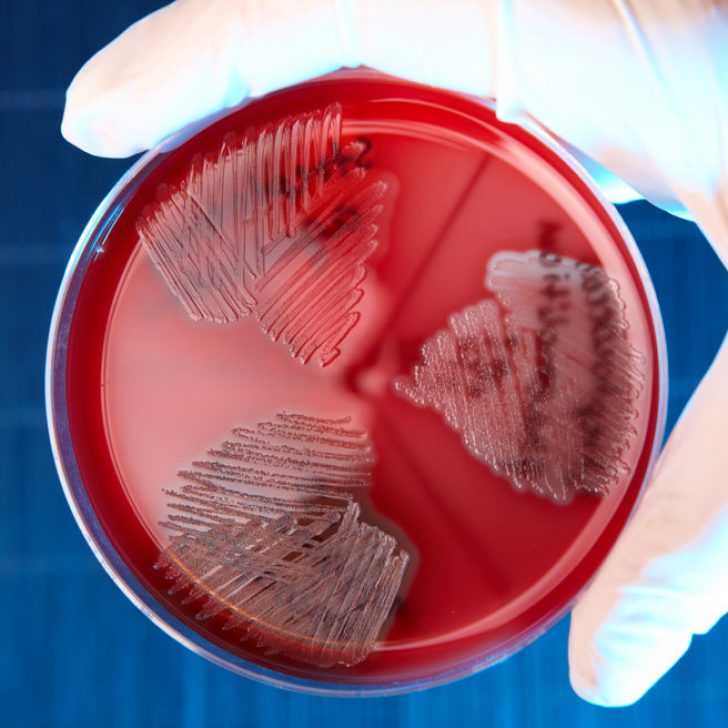
And finally gamma hemolytic streptococci in most cases, are saprophytic (normal) microflora of the intestine and upper respiratory tractwhich, under certain conditions, can still cause urinary tract infections, wounds, as well as septic endocarditis.
How does strep infection occur?
Sources of pathogenic streptococci are sick people and healthy carriers. Infection occurs predominantly through airborne and contact-household (through common dishes, dirty hands, patient care items, etc.). In this case, the pathogen enters the body through the respiratory tract, less often through damage to the skin, as well as the umbilical wound in newborn babies.
After colonization in the primary focus, streptococci begin to actively secrete enzymatic substances, due to which microbial cells can penetrate the blood and lymph. In addition, streptococci produce toxins in the process of vital activity, due to which patients develop a pronounced intoxication syndrome and other signs of the disease.
In addition to the streptococcus infection described above, autoinfection is also possible.For example, when streptococci enter the blood from the ulcers on the skin when they are unsuccessfully squeezed out, from the purulent foci in the oral cavity during dental procedures, as well as from the nasopharynx during the removal of the tonsils or adenoids. In this way, microorganisms spread to the internal organs and cause the development of purulent processes there.
But the systemic diseases, provoked by streptococci, occur not so much because of infection, but because of allergization of the body. Antibodies produced by the system to streptococci are capable of attacking their own tissues in the joints, kidneys, and heart. Therefore, when these microorganisms are long present in the human body or re-enter it, as a result of the hyperimmune reaction, the tissues of these internal organs are damaged.
Symptoms of the most common streptococcal disease
![]()
In childhood, streptococcal infection most often occurs in the form of scarlet fever, and in adults - tonsillitis. If you do not start taking antibiotics in time for these diseases and allow long-term persistence of streptococcus in the body, the development of rheumatism, endocarditis, arthritis and glomerulonephritis is possible.
Streptococcal tonsillitis is manifested by the following symptoms:
- A sharp jump in body temperature to high numbers (39 degrees and above).
- Weakness, chills.
- Soreness in the joints.
- An increase in palatine tonsils (they seem to swell and become covered first with small abscesses, and over time, yellowish purulent raids).
- An increase in cervical lymph nodes.
In addition to the defeat of the tonsils and internal organs (purulent processes in them do not have symptoms typical for streptococcal infection), streptococci cause specific diseases of the skin:

Streptococcus in children
For newborns and infants, streptococcal infection poses a great danger. They have, as a result of infection with streptococcus from their mother, in utero or in childbirth develop skin diseases (impetigo, vulgar ecthyma), as well as very severe meningitis and sepsis. In order to prevent infection of newborns, all pregnant women are examined for streptococcus in the last trimester, risk factors (seeding of pathogenic streptococci from urine during pregnancy, the presence of neonatal streptococcal infection in previously born children, etc.) are evaluated and, if necessary, prophylactic antibiotics are used.
In children after a year streptococcal infection most often manifests itself in the form of scarlet fever.
Symptoms of this disease are as follows:
- The rash, after its disappearance, the skin flakes strongly.
- Angina.
- "Raspberry" language.
- Heat.

This disease against the background of antibiotic therapy almost always ends with full recovery at 7-10 days. In the subsequent ingestion of pathogenic streptococci leads to the development of angina, repeated cases of scarlet fever are very rare.
 Doctors diagnose most of the diseases caused by streptococci by a specific clinical picture (this applies to scarlet fever, sore throat, erysipelas, streptococcal dermatitis). To confirm the diagnosis, an analysis of streptococcus is carried out (smears are taken from the surface of the tonsils, inflamed lesions on the skin, sown urine, pus, blood, etc.). For a more rapid diagnosis of streptococcal infection in recent years are increasingly used modern rapid tests.
Doctors diagnose most of the diseases caused by streptococci by a specific clinical picture (this applies to scarlet fever, sore throat, erysipelas, streptococcal dermatitis). To confirm the diagnosis, an analysis of streptococcus is carried out (smears are taken from the surface of the tonsils, inflamed lesions on the skin, sown urine, pus, blood, etc.). For a more rapid diagnosis of streptococcal infection in recent years are increasingly used modern rapid tests.
Treatment of streptococcal infection
The main and obligatory component of anti-streptococcal treatment is .
It allows you to eliminate the infection much faster and prevent the development of complications from the heart, kidneys and other organs. In the case of angina and scarlet fever, no local antiseptic can replace antibiotics. The choice of a specific antibacterial agent for the treatment of these diseases is determined by the sensitivity of microorganisms. And since all streptococci are sensitive to penicillins, for streptococcal infections, drugs of this group are primarily used, and as an alternative, cephalosporins, macrolides.
For skin diseases caused by streptococcus, the feasibility of systemic antibiotic therapy is determined by the doctor individually. However, erysipelas and prolonged streptoderma with a widespread nature of the inflammatory process is always an indication for prescribing antibiotics.
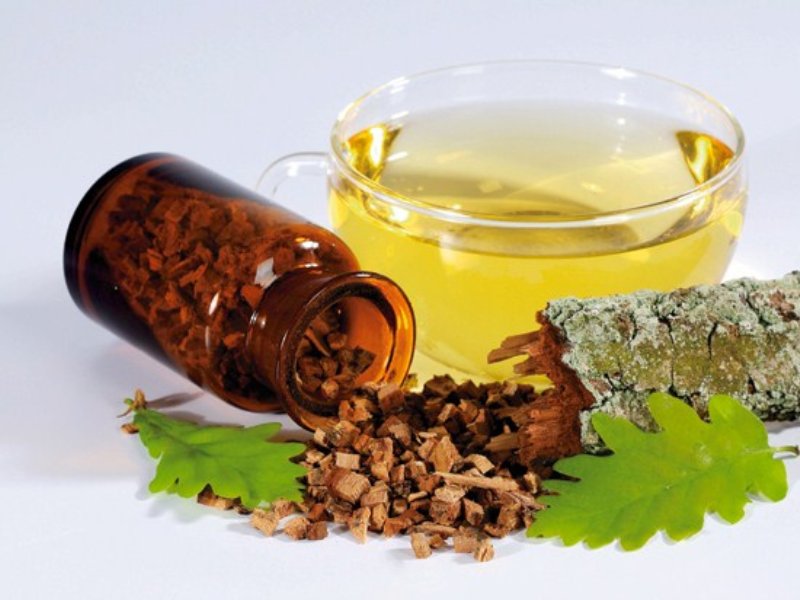 Treatment of folk remedies for streptococcal infections can also be used, but only as an auxiliary. In particular, extracts of medicinal herbs (oak bark, chamomile, succession) are considered effective. They are recommended to be used for gargling and treating affected skin. In addition, you can cook broth hips, fruit drinks from cranberries and take them inside. These drinks contain much to fight the infection.
Treatment of folk remedies for streptococcal infections can also be used, but only as an auxiliary. In particular, extracts of medicinal herbs (oak bark, chamomile, succession) are considered effective. They are recommended to be used for gargling and treating affected skin. In addition, you can cook broth hips, fruit drinks from cranberries and take them inside. These drinks contain much to fight the infection.
Streptococcal infection develops in the oral cavity, in gastrointestinal tract and in the throat. Bacteria belonging to this species are also distributed in the genital area of women and the respiratory tract.
Streptococcus causes a number of diseases, penetrating into various tissues, systems and organs (urinary tract, brain, heart and blood).
Manifesting streptococcal infection in the form of various symptoms. A person can be a carrier of infection, which is very common lately. In this case, the carrier does not feel the pathogenic effects of streptococcus, as its immunity is able to cope with these bacteria.
Several photos (click to enlarge):
| 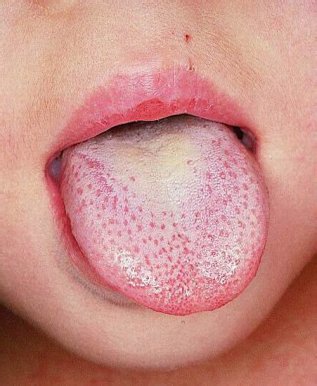 | |
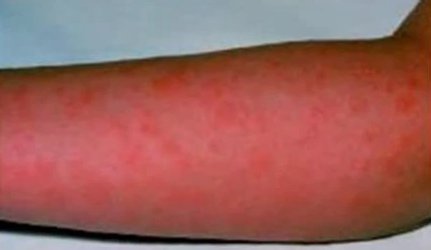 | 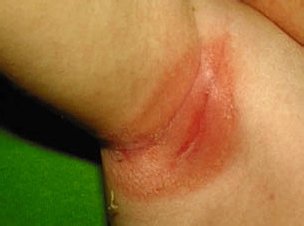 |
|
|
|
Guttate psoriasis - a consequence of streptococcal infection |
Characteristics of streptococcal infection
Streptococcal infection is a group of diseases: scarlet fever, erysipelas, generalized and local purulent and inflammatory processes (abscess, furuncle, phlegmon, wound infection, osteomyelitis, endocarditis and streptococcal sepsis). Streptococci are the cause of rheumatism and inflammation in the kidney area.
The disease-causing effect of streptococcus is the ability to produce poisons (toxins). The pathogen has a negative effect on heart tissue and blood cells, causing the expansion of small vessels.
Streptococcal bacterium, penetrating into the body, secretes enzymes that contribute to its distribution in the tissues. Thus, the pathogenic microorganism independently makes its way for reproduction.
Clinical classification of streptococcal infections:
- Primary - respiratory infections (pharyngitis, sore throat, acute respiratory infections, otitis), skin infections (ecthyma, impetigo, streptoderma), scarlet fever, erysipelas.
- Secondary - non-purulent, having an autoimmune mechanism (rheumatism, vasculitis, glomerulonephritis), toxic-septic, not having an autoimmune component (peritonsillar and metatonsicular abscess, necrotic tissue damage, septic complications).
- Rare - myositis, necrotizing fasciitis, enteritis, toxic shock syndrome, primary peritonitis, focal lesion of internal organs, sepsis.
How does the infection occur?
The causes of streptococcal infection in the body are in contact with a sick person or carrier. The main routes of transmission include the following:
- airborne;
- contact and household;
- through the damaged area of the skin.
More often, streptococcal infection enters the human body through the mucous membrane of the respiratory tract. In the places of introduction of pathogenic microorganisms, an inflammatory focus of a serous or purulent character occurs. In some cases, there is a necrotic phenomenon, that is, the death of the affected tissues. Bacteria secrete special enzymes, thereby penetrating the bloodstream and lymph flow. According to this scheme, streptococcal infectious foci are formed in the internal organs of the person (heart, lungs). Even bone and lymphatic system may suffer from pathogenic exposure to microorganisms.
Streptococcal toxins cause high temperature body, vomiting, headache and impaired consciousness.
A significant manifestation of infection is also an allergic syndrome, the consequences of which are not comforting: damage to the joints, heart and kidneys.
Symptoms of infection
Streptococcal infection manifests itself in the form of various symptoms. This is due to the localization of the pathological process.
This disease is expressed by the appearance on the body of abundant small or otherwise point rash. Symptoms of this disease are as follows:
- a sharp increase in body temperature;
- severe intoxication;
- inflammation of the tonsils (tonsillitis, tonsillitis);
The primary symptoms of scarlet fever include the appearance of chills, general weakness and a pronounced headache. After infection, a rash develops on the skin of the upper body and the hands after about 6-12 hours. The maximum peak of skin lesions is 2-3 days after infection. The symptoms of the disease fade only 2-3 days after the exacerbation.
An infectious disease develops due to the effects of streptococci on the body only if the person has immunity against scarlet fever. Angina is the inflammatory process that affects the tonsils, often palatine. It is due to the unqualified treatment of this disease that the kidneys and the heart are affected.
The reasons for the development of angina are the presence of favorable conditions in the human body for reproduction of streptococci. These conditions include a sharp decrease in the immune system, which occurs more often during cooling. Streptococcal infection penetrates the mucous membranes of the larynx and progresses at an incredible rate. By their nature, the pathological inflammatory process can be divided into:
- necrotic;
- lacunar;
- follicular;
- catarrhal
If the human body has a pronounced lack of barrier functions, then there is the possibility of infection in the surrounding tissues of the tonsils. This can lead to the development of peritonsillary abscess or tonsillitis. Penetrating into the blood, the infection leads to sepsis.
The waste products of pathogenic microorganisms, entering the bloodstream, contribute to the disturbance of the processes of thermoregulation, damage to the tissues of the body. First of all, peripheral and central nervous systemand also liver, kidneys, blood vessels.
The incubation period of such a disease as a sore throat is from 1 to 2 days. At the very beginning the disease is acute:
- Chills appear sharply, persisting in mild cases up to 30 minutes, in severe cases up to several days.
- Feeling weak, loss of appetite.
- Develops stupid headache, not having a specific area of localization.
- There is aching joints and lower back, which persists for 24-48 hours after infection.
The most pronounced symptoms of angina are strong pain in the throat when swallowing. At the very beginning of the development of the disease, discomfort in the larynx area does not bother much. This symptom increases gradually, reaching maximum severity only for 2 days. There is no skin rash on sore throat. On the tonsils, a white-yellow purulent character or white blisters (follicles) appear.
Erysipelas

This disease develops as a result of reproduction on the skin of pathogenic microorganisms - streptococci. Symptoms of the disease are similar to common infectious symptoms:
- increase in body temperature to 39-40 degrees;
- the appearance of severe chills and general weakness;
- development of characteristic muscle pain.
The specific manifestations of erysipelas include inflammatory lesion of the skin on the infected area, which has a bright color and clear boundaries. In accordance with the severity of the disease, only slight redness or hemorrhages and blisters can appear on the skin.
Osteomyelitis
This inflammatory process extends to all elements of the skeletal system. Streptococcal infection causes this kind of disease rarely in about 6-8% of the total number of infected people.
Manifesting the pathological process in the form of purulent lesions of the bone marrow. The inert substance dies off, as a result of which an abscess is formed, which in the course of the course of the disease breaks out.
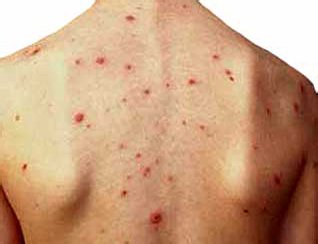
This disease is the limit of the pathological activity of streptococci. More often a similar disease is diagnosed in people with reduced immunity. The development of the infectious process in the body occurs from the primary focus with blood flow. Streptococci penetrate the liver, kidneys, brain, lungs, bones and joints. In the internal organs are formed infectious foci - ulcers.
Streptococcal infection can provoke sepsis for years or even give a lightning reaction, as a result of which death occurs for 2 to 3 days. Slowly developing blood poisoning (chroniosepsis) can be stopped or completely cured, it is important to correctly approach this issue.
Establishing diagnosis
Streptococcal infection is detected by blood and urine tests. To clarify the degree of the body's response to pathogenic microorganisms, an analysis such as electrocardiography is prescribed. To determine the type to which the pathogen belongs, bacteriological research is carried out, involving the taking of biological material from infectious foci:
- analysis of a smear taken from the tonsils;
- pulmonary sputum analysis;
- analysis of lesions on the skin.
When examining the history of the disease, a physician should distinguish streptococcal infection from diphtheria, measles, rubella, infectious mononucleosis, eczema and dermatitis. Analysis of the causative agent of the disease and the patient’s condition allows for a correct diagnosis.
A professional approach to diagnosis is the appointment of an effective and safe treatment.
Professional approach to treatment
Treat streptococcal infection should only after diagnostic measures. Only an analysis of the causative agent of the disease entitles the doctor to prescribe antibacterial drugs. Treatment infectious disease is carried out with the help of antibiotics related to the penicillin series:
- ampicillin;
- benzylpenicillin;
- bicillin-5 or Bicillin-3 (treatment is carried out only 48 hours after the end of penicillin therapy).
Treatment penicillin antibiotics effective, because streptococci are not able to develop resistance to these drugs. If the patient is allergic to this type of antibacterial agents, then it is advisable to prescribe erythromycin antibiotics (Oleandomycin, Erythromycin). Treatment of streptococcal infection with drugs of the sulfonamide group (Co-trimoxazole, Sulfadimethoxine) is not carried out, since these drugs can lead to asymptomatic carriage. It is also not recommended to use tetracyclines (doxycycline, tetracycline), since such treatment relieves the symptoms of the disease, but despite this the patient remains dangerous to others, spreading the infection.
Treatment with antibiotics should end with the mandatory prescription of drugs that normalize the intestinal microflora. For these purposes, suitable means such as Baktisubtil or Linex. This approach allows you to enhance the human immune system and push out toxins from the body.
Treatment of infection should be carried out comprehensively. It is important to comply with general preventive measures:
- Per day drink at least three liters of liquid (tea, fruit juice, fruit drink or water). This will speed up the treatment and help rid the body of toxins.
- Take ascorbic acid, strengthens the walls of blood vessels and is involved in the removal of toxins.
- Take short-term combined medications such as Theraflu or Coldrex containing paracetamol. This will help reduce the symptoms of the disease. Long-term use of these funds is not recommended.
Conservative therapy in the treatment of streptococcal infection also includes the use of local drugs. For example, in case of sore throat, gargling is used only as a prophylaxis.
Treatment with this approach will not give the expected result, but only slightly reduce the severity of symptoms.
The diet for the patient should consist of foods rich in vitamins and minerals, prepared sparingly. The menu should include only highly digestible food, so that the body's forces are not spent on its splitting.
Sanitary rules and regulations (SanPiN)
Preventive measures of streptococcal infection are aimed at the early detection of the disease and timely etiotropic treatment. SanPiN compliance is mandatory in educational institutions, medical institutions and organizations providing social services.
SanPiN consists of the following activities:
- The elimination of foci of infection - hospitalization of patients with moderate and severe forms of the disease.
- Discharge of patients from the hospital and admission to the team - scarlet fever - 12 days after recovery, sore throat - one week after discharge.
- Clinical supervision of patients - after invasive forms of infection and primary erysipelas - 3 months, after sore throat - 12 days, after scarlet fever - 22 days.
SanPiN developed in accordance with the requirements of the legislation and aimed at carrying out preventive measures. Compliance with established rules, and timely action to prevent the spread of primary and secondary forms of streptococcal infection.
Popular
- What is useful mineral water
- What is the name of the Scottish skirt
- What women like a man archer
- Dosage and use of doxycycline when tick bite
- Sinupret - complete instructions
- Number of antennae in arachnid and insect crustaceans
- Help for enterobiasis for the pool, how much is valid
- Ceftriaxone suspension. What is ceftriaxone?
- Third degree breast cancer: prognosis and treatment
- Salt Scrub for the scalp

